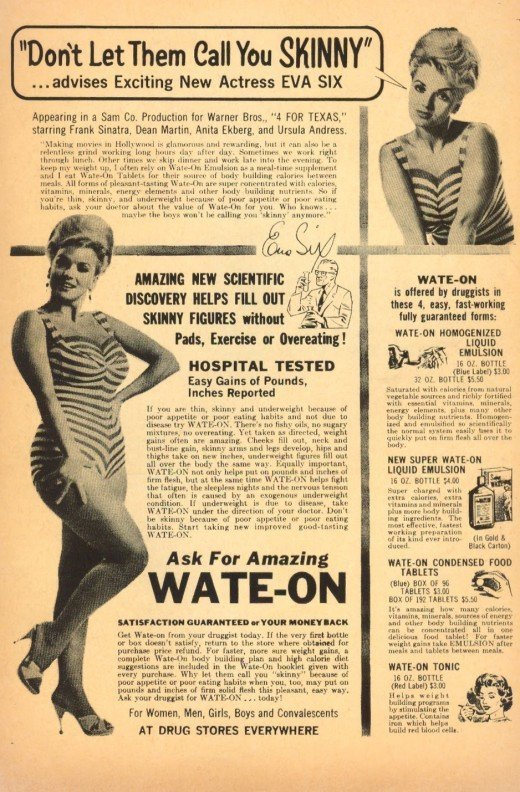Concepts of beauty have varied among cultures and even within the same culture over a span of time. A few decades ago an attractive woman was a more full-bodied and rounded individual than would be the case today.
During the 50s’ the actress in India renowned for her beauty was Nargis who appears on the right. Today, it is Aishwarya Rai (shown on the left) who is considered to be one of the most beautiful women not just in India but in the world; the contrast is fairly obvious. The same holds true in the West, where Marilyn Monroe was the epitome of sexiness and beauty with her quite full figure – today Angelina Jolie is viewed by most people as beautiful. The former was said to wear a dress size of between 8 and 12 – Jolie on the other hand is now rumored to be a size 2! So being thin is “in” and the voluptuous image that was prized in the 40s’ and 50s’ is a thing of the past! Most ads and commercials today focus on ways to lose weight using various diets and dietary products. Of course, this is because of the obesity epidemic that has impacted the US and most Western countries. It is ironical that at a time when the weight of the average woman has risen considerably over the last 50 years, the perspective of what constitutes an ideal weight and figure has gone down in that very same period.
Most ads and commercials today focus on ways to lose weight using various diets and dietary products. Of course, this is because of the obesity epidemic that has impacted the US and most Western countries. It is ironical that at a time when the weight of the average woman has risen considerably over the last 50 years, the perspective of what constitutes an ideal weight and figure has gone down in that very same period.
It is difficult to believe, given today’s focus on slimness and weight loss there was a time not so long ago when the focus of advertisements was on selling women on products that would enable them to GAIN weight and develop a more full figure! It seems an almost alien concept in today’s environment given that an almost rail-thin appearance is the goal and objective of celebrities who view it as the epitome of beauty and a perfect figure. 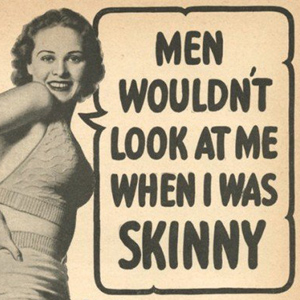
Keep in mind that in the 40s’ 50s’ and even the early part of the 60s’ the celebrities who were heralded for their beauty were individuals like Marilyn Monroe, Jayne Mansfield and Rita Hayworth. These women were each viewed as having attractive figures despite being “full bodied” – and by today’s standards among celebrities they would be viewed as needing to lose weight!  Things began changing in the mid-sixties when Twiggy (shown on the left) became a fashion icon of sorts with a figure that matched her name – although at the time many people thought that her almost emaciated appearance did not make her particularly attractive. Perhaps it was the advent of the mini-skirt which helped promote the notion of slimness synonymous with attractiveness. The emphasis on thinness gathered steam in the seventies and especially the eighties for reasons that are not easily fathomable. It has been argued by some that the desirability of having a fuller and well-rounded body was in the aftermath of the Great Depression and World War II when there were shortages of a lot of foods and rationing was in effect and inadequate nutrition was not uncommon. People became thin and it was viewed as an indication of privation. So someone who was more well-rounded was viewed as being less impacted by these hardships.
Things began changing in the mid-sixties when Twiggy (shown on the left) became a fashion icon of sorts with a figure that matched her name – although at the time many people thought that her almost emaciated appearance did not make her particularly attractive. Perhaps it was the advent of the mini-skirt which helped promote the notion of slimness synonymous with attractiveness. The emphasis on thinness gathered steam in the seventies and especially the eighties for reasons that are not easily fathomable. It has been argued by some that the desirability of having a fuller and well-rounded body was in the aftermath of the Great Depression and World War II when there were shortages of a lot of foods and rationing was in effect and inadequate nutrition was not uncommon. People became thin and it was viewed as an indication of privation. So someone who was more well-rounded was viewed as being less impacted by these hardships.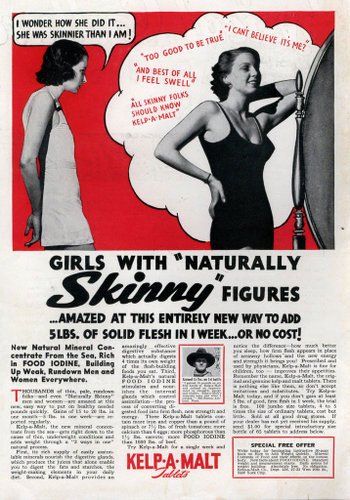
It is an explanation that makes sense because in the context of Indian attitudes to weight, I know that in the fifties and sixties it was generally viewed as a compliment to tell someone they had put on weight because most people tended to be thin to a point of looking almost malnourished – even if they were not! Being on the heavy side was associated with being healthy in those days and also being prosperous. It is not the same any longer in India where there is increased focus on weight loss as the obesity epidemic makes itself felt even in India with the advent of fast food and limited physical activity.
Whatever the reasons for the sea-change in attitudes in the West, it is interesting to view the ads shown below that used to appear regularly extolling women on the positives of gaining weight and how to go about doing so!
.
.
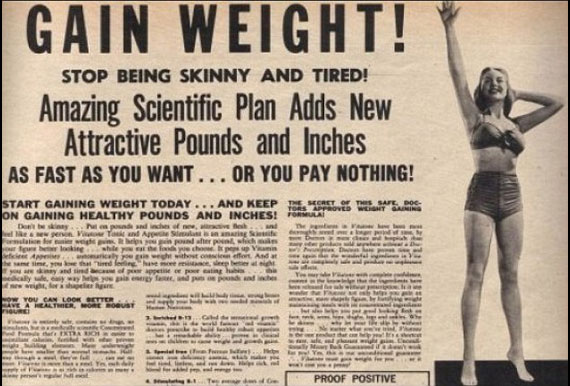
.
.
.
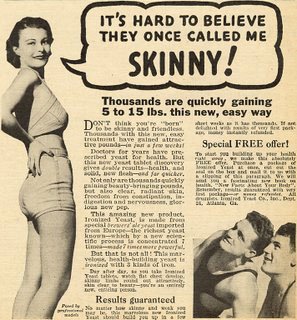
.
.
.

.
.
.
